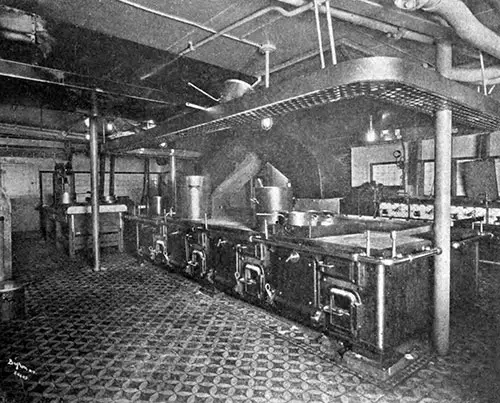Kitchens of Ocean Liners - 1904
Summer kitchens, with their electrical conveniences, and winter kitchens, with nil that they can boast of, whether in home or hotel, fade in glory before that kitchen of kitchens, the culinary department of an ocean liner.
In point of mechanical apparatus used, in economy of space, in neatness and order, it surpasses all other kitchens in the world. Nowhere else where food is prepared are there so many labor-saving devices used, and nowhere else are foods more perfectly prepared or with greater dispatch.
The most mysterious and delicious products of gastronomic art are made in and served from the kitchens of the great ocean steamships. The most whimsical demands of the overfed gourmet will not disconcert the chef, for so high in his profession is he and so fine are the storage facilities, that whatever can be prepared on land can be prepared here.
Planning and working together so that all may run smoothly in this kitchen are the steward and chef.

Galley of an Ocean Liner © 1910 Handbook of Travel
There are three kitchens on a steamer and each is as "ship shape” as the other. "Galleys" they are called and in connection with each galley is a suite of apartments devoted to the creating of specialties Merc the confectioner and baker concoct their ambrosial mixtures.
From the galleys 1,500 or 2.000 persons must be fed for a week or more. It is no easy task to perform. In past years food for an ocean voyage meant salt meat after the first three days.
Mankind today. particularly the men kind, will not put up with this fare, so every steamer is equipped with an electrical cold storage plant and by it means every dainty of the season can be supplied at the table of an ocean steamer.
The kitchen itself, through the main galley, reminds one of great factories, so businesslike is its appearance. Every article used has its particular hook or niche.
As soon as a cook has finished using anything, it goes to the dishwasher, is cleansed, and put away. Nothing is left lying about, as sometimes happens in neat hotel kitchens even.
The range is an affair of forty or fifty tons in weight and is about the size of an ordinary apartment kitchen. Frequently, at the same moment, a dozen cooks are working at it. Each one is attending to his own particular dish.
On one side are the white uniformed cooks, stirring with long ladles the soup, that fills great cylindrical cauldrons, holding fifteen to twenty gallons of the liquid.
Close by stand men managing a broiler that holds two dozen chops. Rolls and bread of all kinds are being baked on another part of the stove. Puddings and warm desserts are being cooked also.
Below this main galley of the ship is the source of the kitchen s bounty, the storerooms. No part of these can he more interesting than the butcher’s shop, where a henchman with cleaver waits to provide whatever cut is required.

Cold Storage Room on a Steamship © 1910 Handbook of Travel
Fish, game, eggs, and bins of vegetables all are to be found in the storerooms, and the whole is like a great market of stalls. Where the vegetables are kept is a company of little kitchen boys, who seem to be allied to the old-time spit turners.
They are vegetable cleaners, who scrape away at beets and carrots when they are not peeling potatoes. This takes up most of their time, for the quantity consumed on shipboard, especially in the third cabin, is enormous.
And peculiarly noticeable is the fact that with all the cooking done there is not an odor to be detected, even in the kitchen, so perfect is the exhaust ventilation and the fresh air supply.
Everything that can be is done by machinery. All the dishes but the silver and more fragile china are washed by machinery. Eggs are boiled by electricity. When the indicator reaches the time set, and automatic arrangement lifts the eggs out of the water in their wire basket and sets them on a table.
Spits for roasting are turned by electricity. There are electric chafing dishes to be used for cooking special dishes in the staterooms.
"Kitchens of Ocean Liners" in House Furnishing Review of Hardware Magazine, New York: Hardware Publishing Co., Vol. XXIX, No. 1, 10 October 1904, p. 40
